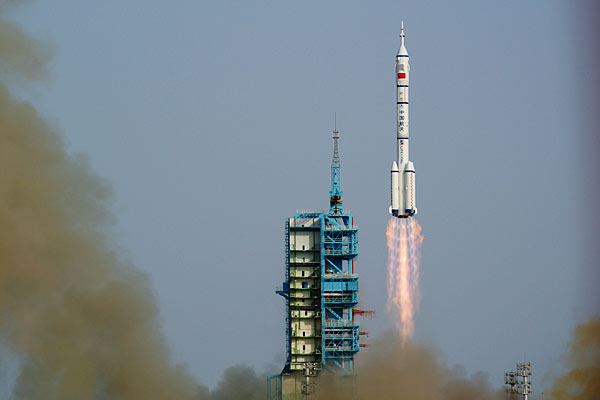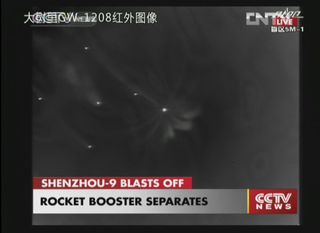How to See China's Space Capsule and Lab Module in Night Sky

The launch of China's fourth human spaceflight this weekend kicked off a major docking test flight, and there's a chance you can see the two spaceships involved in the orbital rendezvous in tonight's night sky.
China's Shenzhou 9 space capsule launched into orbit Saturday (June 16) with a crew of three astronauts aboard, including China's first female spaceflyer Liu Yang. The crew's mission is to rendezvous with China's existing space laboratory module Tiangong 1, which has been circling Earth since its own launch last September.
The two spacecraft are expected to dock for the first time on Monday (June 18), which means that if you live in a part of the world that is along the Shenzhou 9 mission's flight path, tonight is your last chance (weather permitting) to see the space capsule and Tiangong 1 orbiting lab flying separately before they link up.

Here's how to find out if the Shenzhou 9 capsule and Tiangong 1 will be visible from your location:
First, some tips: Keep in mind that the key to spacecraft viewing from Earth are dark skies (away from bright city lights), clear weather and good planning to know when and where to look to see the vehicles. Satellites and manned spacecraft often appear as bright pinpoints of lights that move quickly across the night sky.
The International Space Station, for example, is the largest human-built structure in space and can appear so bright in the sky that its brilliance rivals that of the planet Venus at times. Since the Tiangong 1 lab and Shenzhou 9 capsule are smaller than the space station, they will likely not appear as bright.
The following three websites are good starting points to determining if the vehicles involved in the Shenzhou 9 mission may be visible from your region.
Get the Space.com Newsletter
Breaking space news, the latest updates on rocket launches, skywatching events and more!
Each site will ask for a zip code or city, and then respond with a list of suggested spotting times. The predictions are computed a few days ahead of time are usually accurate within a few minutes. But they have been known to change, so be sure to check frequently for updates.
Another good resource is the website Real Time Satellite Tracking, which shows which part of the Earth a wide variety of spacecraft happen to be flying over at any given moment during the day or night.
China's 13-day Shenzhou 9 mission will dock twice at the Tiangong 1 space lab, first in an automatic mode and then again in a manual mode, to demonstrate spaceflight rendezvous technology. Chinese space officials have said the test flight is vital to the country's plans to begin building a full-fledged space station in 2020.
Editor's note: If you snap amazing photos of China's Shenzhou 9 capsule or Tiangong 1 module in orbit that you'd like to be considered for use in a story or gallery, please send pictures and comments to SPACE.com managing editor Tariq Malik at tmalik@space.com.
You can follow SPACE.com Managing Editor Tariq Malik on Twitter @tariqjmalik. Follow SPACE.com on Twitter @Spacedotcom. We're also on Facebook and Google+.
Join our Space Forums to keep talking space on the latest missions, night sky and more! And if you have a news tip, correction or comment, let us know at: community@space.com.

Tariq is the Editor-in-Chief of Space.com and joined the team in 2001, first as an intern and staff writer, and later as an editor. He covers human spaceflight, exploration and space science, as well as skywatching and entertainment. He became Space.com's Managing Editor in 2009 and Editor-in-Chief in 2019. Before joining Space.com, Tariq was a staff reporter for The Los Angeles Times covering education and city beats in La Habra, Fullerton and Huntington Beach. In October 2022, Tariq received the Harry Kolcum Award for excellence in space reporting from the National Space Club Florida Committee. He is also an Eagle Scout (yes, he has the Space Exploration merit badge) and went to Space Camp four times as a kid and a fifth time as an adult. He has journalism degrees from the University of Southern California and New York University. You can find Tariq at Space.com and as the co-host to the This Week In Space podcast with space historian Rod Pyle on the TWiT network. To see his latest project, you can follow Tariq on Twitter @tariqjmalik.











